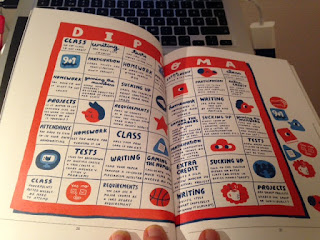Have a peek at peeps magazine!
 If I were to describe the first issue of peeps magazine that the editorial team kindly had sent to me in one word I would go for ‘unpretentious’.
If I were to describe the first issue of peeps magazine that the editorial team kindly had sent to me in one word I would go for ‘unpretentious’. The magazine is jam-packed with really interesting contributions that bring an ethnographic depth to a wide range of culture and communication subjects and the layout, texts and photos form a coherent and very calming symbiosis. When I was flicking through the pages I really wanted to stop and start reading to learn more about ‘The Modern Protagonist’, the sub-title of the first issue.
Eve Houghton kicks off with an interesting anecdote on ‘How to Bank in Kimbe’ that quickly moves into the broader social fabric of Papua New Guinea and how 21st century technology meets traditional village courts. As with most good research-informed writing there is not really a catchy punch line, no ‘ICT4D is changing everything’ or ‘technology is destroying beautiful traditions’ conclusion.
This approach continues throughout the magazine: There is a beautiful stillness in some of the longer pieces as authors take time to explore their subject. Take Victor Barac’ ‘Shakespeares in the Ghetto’ piece on Serbian Hip-Hop for example:
There are enough good anthropologists these days to find an interesting or unexpected field site somewhere, but the two stories that convinced me of the quality of peeps explored seemingly more familiar themes, ‘modern China’ and ‘change in Colombia/Medellin’.My field trip to Belgrade confirmed my initial hypothesis: that hip hop was not a passing fad in Serbia; that it is both an artistic practice and something of a life philosophy for a generation living in an epoch of what must seem like terminal uncertainty, and proximity to poverty (p.56).
Graham Candy reflects on ‘Winning and Losing in Modern China’, focusing on the ‘losers’ and what role gaming communities play in their lives:
Online games represent just one technology, yet they play a multi-faceted role in the life of losers: at once an escape, a site to feel good about practicing and honing online skills, a place of deep friendship and familiarity, a world that stays relatively consistent against a precarious and shifting everyday reality (p.91).
 In the end, this is a ethnographic reportage with some of the core themes of the discipline: How different the familiar often is and how familiar differences really are-especially in the globalized world of capitalism.
In the end, this is a ethnographic reportage with some of the core themes of the discipline: How different the familiar often is and how familiar differences really are-especially in the globalized world of capitalism. I had read about Medellin’s transformation before, but Teresa Bean goes beyond the cable car connecting the poorer, hilly areas with the city and a new rental bike scheme so popular in many other ‘global’ cities. She is questioning some of the participatory initiatives involving state authorities but also manages to find genuine new forms of digital participating through the Ciudad Comuna project that includes both positive representation of youth cultures and more political activities such as mapping human rights abuses in one of the poorest neighborhoods in the city.
But my personal highlight is educational anthropologist Susan D. Blum’s piece on ‘The Game of School’:
So an anthropological look at the game of school shows the impressive expertise inculcated into successful students. Not everyone is successful, however. (…) Many can’t afford to pay for internships for which they don’t get credit. Some don’t get the teacher’s jokes. But the system is strong. It maintains “standards” and, no matter what the reason, everyone is subject to the same evaluation. That’s meritocracy.” The best are rewarded the most. (p.29)These are just some highlights, but they confirm why I hope that peeps will become a success story:
First, the longer articles are such a powerful reminder that academics need to continue to find creative, accessible, ‘popular’ outlets to share reflections and insights beyond academic journals, book chapters or a monograph. Modern anthropology has so much to offer and has become one of the primary avenues to explore, narrate and interpret social change and stability-and peeps presents a broad spectrum of field sites and topics to explore the overarching theme of the first issue.
And second, there really is a space for long-form journalism, for publications like peeps that present places, spaces and people not simply based on a journalistic assignment complete with stringers and international hotels, but on research-driven long-term projects of academics.
Even for a digital enthusiast like myself with a research focus on social media this high-quality printed magazine is a clear win for readers, writers and contemporary new forms ‘public engagement’.
All that is left now is to encourage you to see and read for yourself and pick up a copy of peeps!
Various authors: peeps Issue 01: The Modern Protagonist. ISSN 2369-5463, 144 pages, USD 22.00, Peeps Publishing, Toronto, 2015.




Comments
Post a Comment